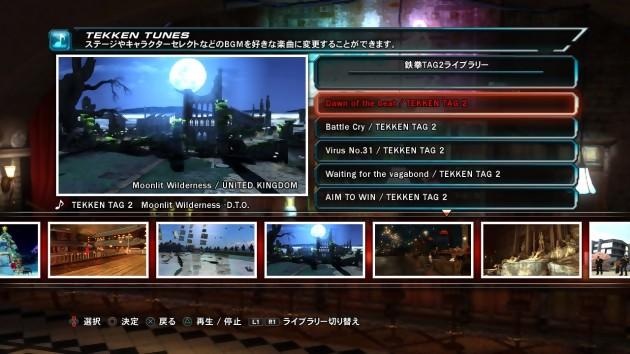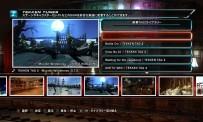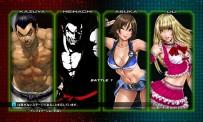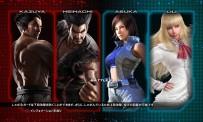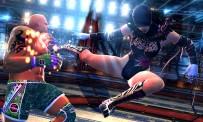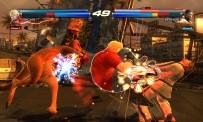 We're not going to do it upside down: broadly speaking, the gameplay of Tekken Tag Tournament 2 repeats that of Tekken 6. We think in particular of the bounce system which makes the combos even more devastating than in the past. Behind this barbaric term actually hides the possibility of bouncing his opponent on the ground after a first series of blows, before continuing the carnage with a new series of attacks. If, on paper, the idea seems simple to apply, the case is much less obvious to manage joystick in hand; because the player must not only place the bounce move with extreme precision, but he must also show a keen sense of timing so as not to hit the void and miss his combo. Like Tekken 6, an excellent control of the bounce makes it easier to bring the opponent towards a wall, and then execute wall combos that make you want to throw yourself out the window. Luckily, the same character can't bounce their opponent twice in a row into the same juggle, but a few instances of death combos have been seen here and there nonetheless. And then good, in Tekken Tag Tournament 2, the bounce is sublimated by the Tag Assault which hurts the head. More concretely, the partner can intervene during the fight just after a rebound, which has the effect of restarting the sequence since the main fighter can then resume the butchery. In order to balance the debates and avoid any form of abuse, the execution of a Tag Assault causes the acolyte, among other things, to lose the red part of his vital gauge, the one precisely which regenerates when he is not fighting. If faced with bags such as our national Béber this compromise is more of a detail than anything else, it is on the other hand a point capable of tipping a high level fight. Especially since the round is lost as soon as the life bar of one of the two characters is completely burned out. A concept very dear to Katsuhiro Harada, let's remember.
We're not going to do it upside down: broadly speaking, the gameplay of Tekken Tag Tournament 2 repeats that of Tekken 6. We think in particular of the bounce system which makes the combos even more devastating than in the past. Behind this barbaric term actually hides the possibility of bouncing his opponent on the ground after a first series of blows, before continuing the carnage with a new series of attacks. If, on paper, the idea seems simple to apply, the case is much less obvious to manage joystick in hand; because the player must not only place the bounce move with extreme precision, but he must also show a keen sense of timing so as not to hit the void and miss his combo. Like Tekken 6, an excellent control of the bounce makes it easier to bring the opponent towards a wall, and then execute wall combos that make you want to throw yourself out the window. Luckily, the same character can't bounce their opponent twice in a row into the same juggle, but a few instances of death combos have been seen here and there nonetheless. And then good, in Tekken Tag Tournament 2, the bounce is sublimated by the Tag Assault which hurts the head. More concretely, the partner can intervene during the fight just after a rebound, which has the effect of restarting the sequence since the main fighter can then resume the butchery. In order to balance the debates and avoid any form of abuse, the execution of a Tag Assault causes the acolyte, among other things, to lose the red part of his vital gauge, the one precisely which regenerates when he is not fighting. If faced with bags such as our national Béber this compromise is more of a detail than anything else, it is on the other hand a point capable of tipping a high level fight. Especially since the round is lost as soon as the life bar of one of the two characters is completely burned out. A concept very dear to Katsuhiro Harada, let's remember.
WTF?!
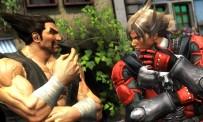 Much easier to make, Tag Combos represent the very essence of Tekken Tag Tournament 2. After placing a launcher to send his enemy into the air, it is possible to switch characters to extend the combo; knowing that this open attack can be carried out at any time. Suffice to say that we have already witnessed mentally ill mix-ups, especially against players who have known the series since birth. And since Tag Combos prevent the opponent from recovering all of their vital bar, Bandai Namco Games cleverly encourages players to go on the offensive. Who says Tag, says naturally combined projections, and Tekken Tag Tournament 2 is no exception to the rule. Like the first episode, certain affinities between such and such a fighter make it possible to take advantage of special holds, but that does not change anything in terms of the damage inflicted from what we have seen. On the other hand, love stories mainly influence the Netsu, or "Rage" mode for neophytes. Clearly, if the main character takes a large number of blows, his partner will then go into a black rage and will see, for a few seconds, the strength of his attacks increased tenfold once on the tatami. This famous "Rage" mode is triggered more or less quickly depending on the relationships between the protagonists, and if you will be advised to avoid associating Jin and Heihachi, it will be more judicious on the other hand to bring together Steve Fox and Paul on the same team. We are not going to tell you all the subtleties of the gameplay of Tekken Tag Tournament 2, but we can't ignore the Tag Crash which, in exchange for a dose of Netsu and life gauge, allows the partner to burst in by breaking the opponent's chain, even after a bounce move. Terrible. In any case, changing characters must be done in a safe way, that is to say when the opponent is at a respectable distance. Because the time of a few frames, the partner cannot execute any attack and is therefore at the mercy of the player opposite.
Much easier to make, Tag Combos represent the very essence of Tekken Tag Tournament 2. After placing a launcher to send his enemy into the air, it is possible to switch characters to extend the combo; knowing that this open attack can be carried out at any time. Suffice to say that we have already witnessed mentally ill mix-ups, especially against players who have known the series since birth. And since Tag Combos prevent the opponent from recovering all of their vital bar, Bandai Namco Games cleverly encourages players to go on the offensive. Who says Tag, says naturally combined projections, and Tekken Tag Tournament 2 is no exception to the rule. Like the first episode, certain affinities between such and such a fighter make it possible to take advantage of special holds, but that does not change anything in terms of the damage inflicted from what we have seen. On the other hand, love stories mainly influence the Netsu, or "Rage" mode for neophytes. Clearly, if the main character takes a large number of blows, his partner will then go into a black rage and will see, for a few seconds, the strength of his attacks increased tenfold once on the tatami. This famous "Rage" mode is triggered more or less quickly depending on the relationships between the protagonists, and if you will be advised to avoid associating Jin and Heihachi, it will be more judicious on the other hand to bring together Steve Fox and Paul on the same team. We are not going to tell you all the subtleties of the gameplay of Tekken Tag Tournament 2, but we can't ignore the Tag Crash which, in exchange for a dose of Netsu and life gauge, allows the partner to burst in by breaking the opponent's chain, even after a bounce move. Terrible. In any case, changing characters must be done in a safe way, that is to say when the opponent is at a respectable distance. Because the time of a few frames, the partner cannot execute any attack and is therefore at the mercy of the player opposite.
It's not at 2D level yet, it's true, but when you remember what you ate with the first Tekken, there is a time in life when you have to know how to appreciate things , and measure the distance traveled."
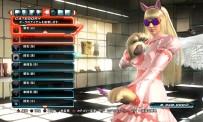 In terms of content, the developers have thought of beginners since the game has the "Fight Lab" mode which, in reality, is a tutorial allowing you to learn the basics of combat Tekken. Harada and his teams have tried to script the trick, but we will especially remember the great educational approach of Lee who, between two attempts at seduction, manages to clearly explain the purpose of each exercise to be performed in the skin of his Super Combot DX. Well, you shouldn't expect to become as tough as Gen1us because the workshops are simplistic, but the "Fight Lab" remains an excellent way to earn credits in order to unlock attacks for the Super Combot DX (based on those of the characters of the game), and thus customize the latter according to his fighting style. Sets even allow you to switch from one configuration to another, which is quite practical in versus. For the rest, no "Story" mode for Tekken Tag Tournament 2 - that of Tekken 6 was however well done – but we will still note the presence of the “Team of two” mode which allows up to four players to fight simultaneously. The operation requires perfect coordination between the two teammates, and the fact that they can swap positions at any time without waiting for a signal from the other adds a dimension that is both strategic and unpredictable to the fighting. There are also 2vs games. 1, which implies some peculiarities for those who prefer to play it solo, such as the vital gauge which regenerates despite everything and the Netsu which engages when one is on the verge of falling into a coma. The roster of Tekken Tag Tournament 2 is obviously one of the game's strong points, with no less than fifty characters automatically included in the game's slate. Tiger, Alex for example), and that others will be given free (Slim Bob, Unknown, Michelle or Miharu Hirano). In short, there will really be enough to make the fans cry.
In terms of content, the developers have thought of beginners since the game has the "Fight Lab" mode which, in reality, is a tutorial allowing you to learn the basics of combat Tekken. Harada and his teams have tried to script the trick, but we will especially remember the great educational approach of Lee who, between two attempts at seduction, manages to clearly explain the purpose of each exercise to be performed in the skin of his Super Combot DX. Well, you shouldn't expect to become as tough as Gen1us because the workshops are simplistic, but the "Fight Lab" remains an excellent way to earn credits in order to unlock attacks for the Super Combot DX (based on those of the characters of the game), and thus customize the latter according to his fighting style. Sets even allow you to switch from one configuration to another, which is quite practical in versus. For the rest, no "Story" mode for Tekken Tag Tournament 2 - that of Tekken 6 was however well done – but we will still note the presence of the “Team of two” mode which allows up to four players to fight simultaneously. The operation requires perfect coordination between the two teammates, and the fact that they can swap positions at any time without waiting for a signal from the other adds a dimension that is both strategic and unpredictable to the fighting. There are also 2vs games. 1, which implies some peculiarities for those who prefer to play it solo, such as the vital gauge which regenerates despite everything and the Netsu which engages when one is on the verge of falling into a coma. The roster of Tekken Tag Tournament 2 is obviously one of the game's strong points, with no less than fifty characters automatically included in the game's slate. Tiger, Alex for example), and that others will be given free (Slim Bob, Unknown, Michelle or Miharu Hirano). In short, there will really be enough to make the fans cry.
Like a Snoop Lion in a cage
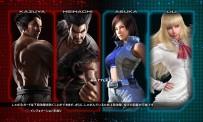 The character selection screen is clearly mouth-watering, the voice-over that accompanies each validation too, and the quality of the sets show that the developers have an eye for detail. It's not yet at the level of 2D, it's true, but when you remember what you ate with the first Tekken, there is a moment in life when you have to know how to appreciate things, and measure the progress made. The destructible levels are part of the show, and the modeling of the characters has gained in finesse, even if we continue to see an imbalance between the fighters. The motion blur is always there to energize the animation and accentuate the force released by the shots, and the soundtrack puts pressure on the ears. As for the interface, it remains sober and sufficiently clear so that one does not get lost in the menus, especially since the latter are quite numerous in Tekken Tag Tournament 2. Finally, let's say a few words about the online mode which benefits from the World Tekken Federation, a completely free service through which followers can access a whole host of statistics, in order to better understand the fighting style of their opponents. The WTF (it was easy) is also an effective way to work on the affinities between the fighters, exchange ideas on the forums and even create clans to smash mouths in gangs. At the time of writing this review, the World Tekken Federation is oddly not online yet, although it was supposed to be activated yesterday when the game was released in the United States. On the other hand, we were able to play a few games against sparring partners located on the other side of the world, and the netcode proved to be particularly solid. Mention favorite!
The character selection screen is clearly mouth-watering, the voice-over that accompanies each validation too, and the quality of the sets show that the developers have an eye for detail. It's not yet at the level of 2D, it's true, but when you remember what you ate with the first Tekken, there is a moment in life when you have to know how to appreciate things, and measure the progress made. The destructible levels are part of the show, and the modeling of the characters has gained in finesse, even if we continue to see an imbalance between the fighters. The motion blur is always there to energize the animation and accentuate the force released by the shots, and the soundtrack puts pressure on the ears. As for the interface, it remains sober and sufficiently clear so that one does not get lost in the menus, especially since the latter are quite numerous in Tekken Tag Tournament 2. Finally, let's say a few words about the online mode which benefits from the World Tekken Federation, a completely free service through which followers can access a whole host of statistics, in order to better understand the fighting style of their opponents. The WTF (it was easy) is also an effective way to work on the affinities between the fighters, exchange ideas on the forums and even create clans to smash mouths in gangs. At the time of writing this review, the World Tekken Federation is oddly not online yet, although it was supposed to be activated yesterday when the game was released in the United States. On the other hand, we were able to play a few games against sparring partners located on the other side of the world, and the netcode proved to be particularly solid. Mention favorite!